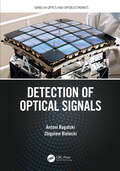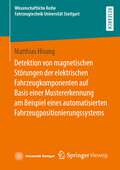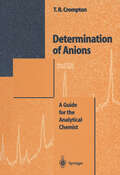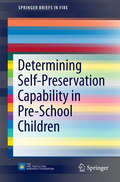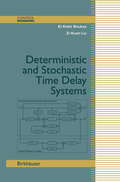- Table View
- List View
Detection of Intrusions and Malware, and Vulnerability Assessment: 14th International Conference, DIMVA 2017, Bonn, Germany, July 6-7, 2017, Proceedings (Lecture Notes in Computer Science #10327)
by Michalis Polychronakis Michael MeierThis book constitutes the refereed proceedings of the 14th International Conference on Detection of Intrusions and Malware, and Vulnerability Assessment, DIMVA 2017, held in Bonn, Germany, in July 2017. The 18 revised full papers included in this book were carefully reviewed and selected from 67 submissions. They present topics such as enclaves and isolation; malware analysis; cyber-physical systems; detection and protection; code analysis; and web security.
Detection of Liquid Explosives and Flammable Agents in Connection with Terrorism (NATO Science for Peace and Security Series B: Physics and Biophysics)
by Hiltmar Schubert Andrey KuznetsovThe organization of an Advanced Research Workshop with the title “Detection and Disposal of Liquid Explosives and Flammable Agents in Connection with Terrorism” was motivated by international findings about activities in this field of application. This ARW followed a meeting about the “Detection of Disposal Improvised Explosives” (St. Petersburg, 2005). Both items show the logistic problems as one of the lessons, terrorists have to overcome. These problems are connected with the illegal supply and transport of explosives and fuels and as counter-measure the detection of these materials. The invention of liquid explosives goes back to the middle of the 19th century and was used for special purposes in the commercial field of application. Because of the high sensitivity of liquid explosives against mechanical shock, caused by adiabatic compression of air-bobbles producing “hot spots” as origin of initiation the commercial application was not very successful. Because of this high risk, liquid explosives are not used in military or commercial application with some exceptions. In the commercial field explosives as slurries or emulsions consisting of suitable salts (Ammoniumnitrate etc.) and water are used to a large extend because of their high insensitivity. In many cases these slurries or emulsions were unfit for terrorist actions, because of their low sensitivity, large critical diameter and using in confinement. In the military field liquid explosives are used in World War I and II as bomb-fillings.
Detection of Low-Level Optical Signals: Photodetectors, Focal Plane Arrays and Systems (Solid-State Science and Technology Library #4)
by M.A. TrishenkovThis book is addressed to designers of photodetectors and photodetecting systems, designers of focal plane arrays, charge-coupled devices, specialists in IR technologies, designers of optoelectronic detecting, guiding and tracking systems, systems for IR direction finders, lidars, lightwave communication systems, IR imagers. All these specialists are united by one common purpose: they are all striving to catch the weakest possible optical signal. The most important characteristic of photosensitive devices is their detectivity, which determines the lowest level of optical signal they are able to detect above the noise level. These threshold characteristics define the most important tactical and technical parameters of the entire optoelectronic system, such as its range, resolution, precision. The threshold characteristics of optoelectronic system depend on many of its components; all designers agree, however, that the critically responsible part of the system is the photodetector [1]. By the end of the 1960s the physicists and the engineers were able to overcome many obstacles and to create photodetectors (at least single-element or few-element ones) which covered all the main optical bands (0. 4 . . . 2,2 . . . 3, 3 . . . 5,8 . . . 14 J. . Lm), carried out the detection almost without any loss (the quantum yield being as high as 0. 7 . . . 0. 9), and reduced the noise level to the lowest possible limit.
Detection of Melt Ponds on Arctic Sea Ice with Optical Satellite Data (Hamburg Studies on Maritime Affairs #25)
by Anja RöselThe Arctic sea ice is characterized by profound changes caused by surface melting processes and the formation of melt ponds in summer. Melt ponds contribute to the ice-albedo feedback as they reduce the surface albedo of sea ice, and hence accelerate the decay of Arctic sea ice. To quantify the melting of the entire Arctic sea ice, satellite based observations are necessary. Due to different spectral properties of snow, ice, and water, theoretically, multi-spectral optical sensors are necessary for the analysis of these distinct surface types. This study demonstrates the potential of optical sensors to detect melt ponds on Arctic sea ice. For the first time, an Arctic-wide, multi-annual melt pond data set for the years 2000-2011 has been created and analyzed.
Detection of Non-Amplified Genomic DNA (Soft and Biological Matter)
by Giuseppe Spoto and Roberto CorradiniThis book offers an overview of state-of-the-art in non amplified DNA detection methods and provides chemists, biochemists, biotechnologists and material scientists with an introduction to these methods. In fact all these fields have dedicated resources to the problem of nucleic acid detection, each contributing with their own specific methods and concepts. This book will explain the basic principles of the different non amplified DNA detection methods available, highlighting their respective advantages and limitations. Non-amplified DNA detection can be achieved by adopting different techniques. Such techniques have allowed the commercialization of innovative platforms for DNA detection that are expected to break into the DNA diagnostics market. The enhanced sensitivity required for the detection of non amplified genomic DNA has prompted new strategies that can achieve ultrasensitivity by combining specific materials with specific detection tools. Advanced materials play multiple roles in ultrasensitive detection. Optical and electrochemical detection tools are among the most widely investigated to analyze non amplified nucleic acids. Biosensors based on piezoelectric crystal have been also used to detect unamplified genomic DNA. The main scientific topics related to DNA diagnostics are discussed by an outstanding set of authors with proven experience in this field.
Detection of Optical Signals (Series in Optics and Optoelectronics)
by Antoni Rogalski Zbigniew BieleckiDetection of Optical Signals provides a comprehensive overview of important technologies for photon detection, from the X-ray through ultraviolet, visible, infrared to far-infrared spectral regions. It uniquely combines perspectives from many disciplines, particularly within physics and electronics, which are necessary to have a complete understanding of optical receivers.This interdisciplinary textbook aims to: Guide readers into more detailed and technical treatments of readout optical signals Give a broad overview of optical signal detection including terahertz region and two-dimensional material Help readers further their studies by offering chapter-end problems and recommended reading. This is an invaluable resource for graduate students in physics and engineering, as well as a helpful refresher for those already working with aerospace sensors and systems, remote sensing, thermal imaging, military imaging, optical telecommunications, infrared spectroscopy, and light detection.
Detection of Optical Signals (Series in Optics and Optoelectronics)
by Antoni Rogalski Zbigniew BieleckiDetection of Optical Signals provides a comprehensive overview of important technologies for photon detection, from the X-ray through ultraviolet, visible, infrared to far-infrared spectral regions. It uniquely combines perspectives from many disciplines, particularly within physics and electronics, which are necessary to have a complete understanding of optical receivers.This interdisciplinary textbook aims to: Guide readers into more detailed and technical treatments of readout optical signals Give a broad overview of optical signal detection including terahertz region and two-dimensional material Help readers further their studies by offering chapter-end problems and recommended reading. This is an invaluable resource for graduate students in physics and engineering, as well as a helpful refresher for those already working with aerospace sensors and systems, remote sensing, thermal imaging, military imaging, optical telecommunications, infrared spectroscopy, and light detection.
The Detective: The addictive, edge-of-your-seat mystery and Sunday Times crime book of the year (Detective Kamil Rahman #3)
by Ajay Chowdhury*As seen on The One Show**Sunday Times Crime Book of the Month*'A rip-roaring mystery that's engrossing from start to finish' ABIR MUKHERJEEHAS SOMEONE GOT AWAY WITH MURDER?On the verge of a four-billion-dollar deal, a tech entrepreneur from Shoreditch is found dead in a construction site, which leads to the discovery of three skeletons over a hundred years old.But as fresh bodies turn up, can Detective Kamil - along with his friend Anjoli - prevent another murder?Desperate to solve his first case for the Met, will Kamil put his reputation on the line... then cross it?*The thrilling new Kamil Rahman mystery, THE SPY, is available to pre-order now!*Praise for the Detective Kamil Rahman series:'Hugely entertaining' ANN CLEEVES'The Detective has all the ingredients for a great crime series' SUN'[Kamil is a] likeable inspector . . . We shall hear much more of him' DAILY MAIL'An elegantly constructed thriller' THE TIMES'Outstanding' SUNDAY TIMES
Detectors in Particle Physics: A Modern Introduction
by Georg Viehhauser Tony WeidbergThis textbook provides an accessible yet comprehensive introduction to detectors in particle physics. It emphasises the core physics principles, enabling a deeper understanding of the subject for further and more advanced studies. In addition to the discussion of the underlying detector physics, another aspiration of this book is to introduce the reader to practically important aspects of particle detectors, like electronics, alignment, calibration and simulation of particle detectors. Case studies of the various applications of detectors in particle physics are provided.The primary audience is graduate students in particle or nuclear physics, in addition to advanced undergraduate students in physics.Key Features: Provides an accessible yet thorough discussion of the basic physics principles needed to understand how particle detectors work. Presents applications of the basic physics concepts to examples of modern detectors. Discusses practically important aspects like electronics, alignment, calibration and simulation of particle detectors. Contains exercises for each chapter to further understanding. For more information and errata please see the authors companion webpage https://ppdetectors.web.ox.ac.uk/This webpage also allows instructors to request a copy of the solutions manual. This eBook was published Open Access with funding support from the Sponsoring Consortium for Open Access Publishing in Particle Physics (SCOAP3).
Detectors in Particle Physics: A Modern Introduction
by Georg Viehhauser Tony WeidbergThis textbook provides an accessible yet comprehensive introduction to detectors in particle physics. It emphasises the core physics principles, enabling a deeper understanding of the subject for further and more advanced studies. In addition to the discussion of the underlying detector physics, another aspiration of this book is to introduce the reader to practically important aspects of particle detectors, like electronics, alignment, calibration and simulation of particle detectors. Case studies of the various applications of detectors in particle physics are provided.The primary audience is graduate students in particle or nuclear physics, in addition to advanced undergraduate students in physics.Key Features: Provides an accessible yet thorough discussion of the basic physics principles needed to understand how particle detectors work. Presents applications of the basic physics concepts to examples of modern detectors. Discusses practically important aspects like electronics, alignment, calibration and simulation of particle detectors. Contains exercises for each chapter to further understanding. For more information and errata please see the authors companion webpage https://ppdetectors.web.ox.ac.uk/This webpage also allows instructors to request a copy of the solutions manual. This eBook was published Open Access with funding support from the Sponsoring Consortium for Open Access Publishing in Particle Physics (SCOAP3).
Detektion von magnetischen Störungen der elektrischen Fahrzeugkomponenten auf Basis einer Mustererkennung am Beispiel eines automatisierten Fahrzeugpositionierungssystems (Wissenschaftliche Reihe Fahrzeugtechnik Universität Stuttgart)
by Matthias HisungMatthias Hisung stellt ein neuartiges Assistenzsystem zur automatisierten Fahrzeugpositionierung für das induktive Laden (APIC) vor. Darüber hinaus wird eine neue Methode zur Detektion von magnetischen Störungen (MDMS) durch elektrische Fahrzeugkomponenten auf Basis einer Mustererkennung eingeführt. Das Assistenzsystem lässt sich hierbei auf unterschiedliche Fahrzeugtypen anwenden und übernimmt für die fahrende Person die Aufgabe der Positionierung, um eine Komfortsteigerung zu erzielen. Durch die neuartige Methode wird eine deutliche Verbesserung der Positionsermittlung und damit einhergehend eine Erhöhung des Positionierungsradius für das induktive Laden ermöglicht.
Detergents (The Handbook of Environmental Chemistry #3 / 3F)
by F. Balk J. G. Batelaan J. G. Blumberg R. S. Boethling L. Butterwick P. Christophliemk J. S. Falcone T. Feijtel P. Gerike H. L. Gewanter P. A. Gilbert C.G.van Ginkel W. E. Gledhill D. Gleisberg J. L. Hamelink M. S. Holt H. L. Hoyt H. B. Kramer D. G. Lynch G. C. Mitchell H. J. Opgenorth H. A. Painter M. Potokar K. Raymond R. J. WatkinsonEnvironmental Chemistry is a relatively young science. Interest in this subject, however, is growing very rapidly and, although no agreement has been reached as yet about the exact content and limits of this interdisciplinary subject, there appears to be increasing interest in seeing environmental topics which are based on chemistry embodied in this subject. One of the first objectives of Environ mental Chemistry must be the study of the environment and of natural chemical processes which occur in the environment. A major purpose of this series on Environmental Chemistry, therefore, is to present a reasonably uniform view of various aspects of the chemistry of the environment and chemical reactions occuring in the environment. The industrial activities of man have given a new dimension to Environ mental Chemistry. We have now synthesized and described over five million chemical compounds and chemical industry produces about one hundred and fifty million tons of synthetic chemicals annually. We ship billions of tons of oil per year and through mining operations and other geophysical modifications, large quantities of inorganic and organic materials are released from their natural deposits. Cities and metropolitan areas of up to 15 million inhabitants produce large quantities ofwaste in relatively small and confined areas. Much of the chemical products and was te products of modern society are released into the environment either during production, storage, transport, use or ultimate disposal. These released materials participate in natural cycles and reactions and frequently lead to interference and disturbance of natural systems.
Deterioration and Optimal Rehabilitation Modelling for Urban Water Distribution Systems (IHE Delft PhD Thesis Series)
by Yi ZhouPipe failures in water distribution systems can have a serious impact and hence it’s important to maintain the condition and integrity of the distribution system. This book presents a whole-life cost optimisation model for the rehabilitation of water distribution systems. It combines a pipe breakage number prediction model with a pipe criticality assessment model, which enables the creation of a well-constructed and more tightly constrained optimisation model. The pipe breakage number prediction model combines information on the physical characteristics of the pipes with historical information on breakage and failure rates. A weighted multiple nonlinear regression analysis is applied to describe the condition of different pipe groups. The criticality assessment model combines a pipe’s condition with its hydraulic significance through a modified TOPSIS. This model enables the optimisation to focus its efforts on those important pipes. The whole life cost optimal rehabilitation model is a multiple-objective and multiple-stage model, which provides a suite of rehabilitation decisions that minimise the whole life cost while maximising its long-term performance. The optimisation model is solved using a modified NSGA-II. The utility of the developed models is that it allows decision makers to prioritize their rehabilitation strategy in a proactive and cost-effective manner.
Deterioration and Optimal Rehabilitation Modelling for Urban Water Distribution Systems (IHE Delft PhD Thesis Series)
by Yi ZhouPipe failures in water distribution systems can have a serious impact and hence it’s important to maintain the condition and integrity of the distribution system. This book presents a whole-life cost optimisation model for the rehabilitation of water distribution systems. It combines a pipe breakage number prediction model with a pipe criticality assessment model, which enables the creation of a well-constructed and more tightly constrained optimisation model. The pipe breakage number prediction model combines information on the physical characteristics of the pipes with historical information on breakage and failure rates. A weighted multiple nonlinear regression analysis is applied to describe the condition of different pipe groups. The criticality assessment model combines a pipe’s condition with its hydraulic significance through a modified TOPSIS. This model enables the optimisation to focus its efforts on those important pipes. The whole life cost optimal rehabilitation model is a multiple-objective and multiple-stage model, which provides a suite of rehabilitation decisions that minimise the whole life cost while maximising its long-term performance. The optimisation model is solved using a modified NSGA-II. The utility of the developed models is that it allows decision makers to prioritize their rehabilitation strategy in a proactive and cost-effective manner.
Determinants of Construction Project Success in India (Topics in Safety, Risk, Reliability and Quality #23)
by Kumar Neeraj JhaThis study presents exploratory work and seeks to identify and evaluate the success and failure factors that could form a guideline for further study and to some extent help professionals to understand some critical aspects that impact project performance concerning construction in India. A total of 55 attributes affecting the performance of construction projects are analysed in terms of their level of influence on four key performance criteria – schedule, cost, quality, and no disputes – using a two-stage questionnaire survey. These attributes are then further analysed, interpreted and evaluated. Based on the critical success factors obtained from the study, a neural network model-based predictive model for project performance has been developed. The performance prediction models have been derived for all four project performance criteria. Further, a hypothesis that ‘project success’ is influenced by ‘success traits’ has also been formulated. The hypothesized positive inter-relationships between success traits and project success have been tested using the structural equation modelling technique. Besides supporting the intuition of past researchers in recognizing ‘coordination’ as a key success factor, this study has revealed that coordination is not an isolated and independent activity, but is a typical management function with an inherent role in all major management activities. Key elements affecting coordination have also been identified and their influence on coordination effort has been studied. Furthermore, the present study has also identified three broad skill groups required of effective project coordinators. The results are validated through case studies of live projects and structured interviews with experts in the field of construction management.
Determination of Anions: A Guide for the Analytical Chemist
by Thomas R. CromptonThe author has drawn together almost all published methods since 1975 on the determination of anions in all types of matrices. He presents the methods in a logical manner so that the reader can quickly gain access to the method and types of instrumentation available.
The Determination of Chemical Elements in Food: Applications for Atomic and Mass Spectrometry
by Sergio CaroliState-of-the-art tools and applicationsfor food safety and food science research Atomic spectroscopy and mass spectrometry are important tools for identifying and quantifying trace elements in food products-elements that may be potentially beneficial or potentially toxic. The Determination of Chemical Elements in Food: Applications for Atomic and Mass Spectrometry teaches the reader how to use these advanced technologies for food analysis. With chapters written by internationally renowned scientists, it provides a detailed overview of progress in the field and the latest innovations in instrumentation and techniques, covering: Fundamentals and method development, selected applications, and speciation analysis Applications of atomic absorption spectrometry, inductively coupled plasma atomic emission spectrometry, and inductively coupled plasma mass spectrometry Applications to foods of animal origin and applications to foods of vegetable origin Foreseeable developments of instrumental spectrometric techniques that can be exploited to better protect consumers' health, with a full account of the most promising trends in spectrometric instrumentation and ancillary apparatuses Applicable laws and regulations at the national and international levels This is a core reference for scientists in food laboratories in the public andprivate sectors and academia, as well as members of regulatory bodies that deal with food safety.
Determination of Target Xenobiotics and Unknown Compound Residues in Food, Environmental, and Biological Samples (Chromatographic Science Series)
by Tomasz Tuzimski Joseph ShermaXenobiotics are chemical compounds foreign to a given biological system. In animals and humans, xenobiotics include drugs, drug metabolites, and environmental pollutants. In the environment, xenobiotics include synthetic pesticides, herbicides, and industrial pollutants. Many techniques are used in xenobiotics residue analysis; the method selected depends on the complexity of the sample, the nature of the matrix/analytes, and the analytical techniques available. This reference will help the analyst develop effective and validated analytical strategies for the analysis of hundreds of different xenobiotics on hundreds of different sample types, quickly, accurately and at acceptable cost.
Determination of Target Xenobiotics and Unknown Compound Residues in Food, Environmental, and Biological Samples (Chromatographic Science Series)
by Tomasz Tuzimski Joseph ShermaXenobiotics are chemical compounds foreign to a given biological system. In animals and humans, xenobiotics include drugs, drug metabolites, and environmental pollutants. In the environment, xenobiotics include synthetic pesticides, herbicides, and industrial pollutants. Many techniques are used in xenobiotics residue analysis; the method selected depends on the complexity of the sample, the nature of the matrix/analytes, and the analytical techniques available. This reference will help the analyst develop effective and validated analytical strategies for the analysis of hundreds of different xenobiotics on hundreds of different sample types, quickly, accurately and at acceptable cost.
Determining Self-Preservation Capability in Pre-School Children (SpringerBriefs in Fire)
by Anca Taciuc Anne S. DederichsThis SpringerBrief explores the evacuation characteristics of children and their self-preservation capability during fire situations. An international survey among teachers from day-care centers and experts in child development indicates an age-limit at which pre-school children may be considered capable of evacuating a location without direct intervention by an instructor. The survey examines the ability of children to understand and follow simple instructions, walk on horizontal surfaces without physical support, and walk down stairs. It also studies how fire safety installations and fire drills differ between countries. A literature review and a presentation of the method applied are included. This data can be applied to evacuation procedures, building codes, and fire regulations. Determining Self-Preservation Capability in Pre-School Children is intended for practitioners as a tool for analyzing evacuation safety issues and developing methods removing potential hazards. Researchers working in a related field will also find the book valuable.
Determinism, Holism, and Complexity
by Claudio Pellegrini Paola Cerrai Paolo Freguglia Vieri Benci Giorgio IsraelDeterminism, holism and complexity: three epistemological attitudes that have easily identifiable historical origins and developments. Galileo believed that it was necessary to "prune the impediments" to extract the mathematical essence of physical phenomena, to identify the math ematical structures representing the underlying laws. This Galilean method was the key element in the development of Physics, with its extraordinary successes. Nevertheless the method was later criticized because it led to a view of nature as essentially "simple and orderly", and thus by choosing not to investigate several charac teristics considered as an "impediment", several essential aspects of the phenomenon under investigation might be left out. The Galilean point of view also contains an acknowledgement of the central role played by the causal nexus among phenomena. The mechanistic-deterministic de scription of reality - for instance, a la Laplace - although acknowledging that it is not possible to predict phenomena exactly owing to unavoid able measurement error, is based on the recognition of the their causal nature, even in an ontological sense. Consequently, deterministic predic tion became the methodological fulcrum of mathematical physics. But although mechanistic determinism has had and, in many cases, still has, considerable success in Physics, in other branches of science this situa tion is much less favourable.
Deterministic and Stochastic Time-Delay Systems (Control Engineering)
by El-Kebir Boukas Zi-Kuan LiuMost practical processes such as chemical reactor, industrial furnace, heat exchanger, etc., are nonlinear stochastic systems, which makes their con trol in general a hard problem. Currently, there is no successful design method for this class of systems in the literature. One common alterna tive consists of linearizing the nonlinear dynamical stochastic system in the neighborhood of an operating point and then using the techniques for linear systems to design the controller. The resulting model is in general an approximation of the real behavior of a dynamical system. The inclusion of the uncertainties in the model is therefore necessary and will certainly improve the performance of the dynamical system we want to control. The control of uncertain systems has attracted a lot of researchers from the control community. This topic has in fact dominated the research effort of the control community during the last two decades, and many contributions have been reported in the literature. Some practical dynamical systems have time delay in their dynamics, which makes their control a complicated task even in the deterministic case. Recently, the class ofuncertain dynamical deterministic systems with time delay has attracted some researchers, and some interesting results have been reported in both deterministic and stochastic cases. But wecan't claim that the control problem ofthis class ofsystems is completely solved; more work must be done for this class of systems.
Deterministic Flexibility Analysis: Theory, Design, and Applications
by Chuei-Tin Chang Vincentius Surya Kurnia AdiTraditionally, design and control decisions are made in sequential stages over the life cycle of a chemical plant. In the design phase, the optimal operating conditions and the corresponding material and energy balance data are established mainly on the basis of economic considerations. In the subsequent step, the control systems are configured to maintain the key process conditions at the fixed nominal values. Because it is often desirable to address the operability issues at the earliest possible stage before stipulation of control schemes, the systematic incorporation of flexibility analysis in process synthesis and design has received considerable attention in recent years. This book focuses to a large extent on computation and implementation methods of deterministic performance measures, i.e., the steady-state, volumetric, dynamic and temporal flexibility indices, in various applications. The formal definitions of several available performance indices, their mathematical formulations, and the corresponding algorithms and codes are provided in sufficient detail to facilitate implementation. To show the utility of flexibility analyses, the book presents several practical case studies including membrane modules and heat-exchanger networks, solar-driven membrane distillation desalination systems, and hybrid power generation systems. It also includes MATLAB and GAMS codes.
Deterministic Flexibility Analysis: Theory, Design, and Applications
by Chuei-Tin Chang Vincentius Surya Kurnia AdiTraditionally, design and control decisions are made in sequential stages over the life cycle of a chemical plant. In the design phase, the optimal operating conditions and the corresponding material and energy balance data are established mainly on the basis of economic considerations. In the subsequent step, the control systems are configured to maintain the key process conditions at the fixed nominal values. Because it is often desirable to address the operability issues at the earliest possible stage before stipulation of control schemes, the systematic incorporation of flexibility analysis in process synthesis and design has received considerable attention in recent years. This book focuses to a large extent on computation and implementation methods of deterministic performance measures, i.e., the steady-state, volumetric, dynamic and temporal flexibility indices, in various applications. The formal definitions of several available performance indices, their mathematical formulations, and the corresponding algorithms and codes are provided in sufficient detail to facilitate implementation. To show the utility of flexibility analyses, the book presents several practical case studies including membrane modules and heat-exchanger networks, solar-driven membrane distillation desalination systems, and hybrid power generation systems. It also includes MATLAB and GAMS codes.





